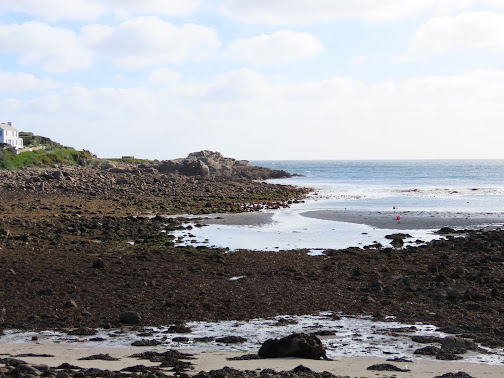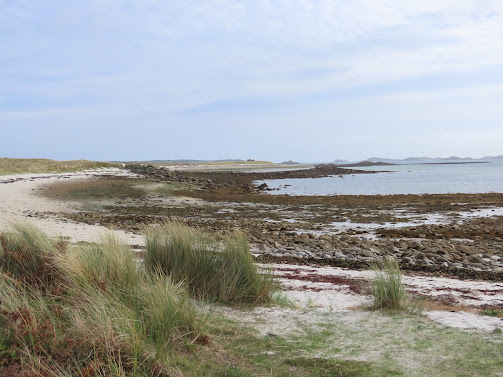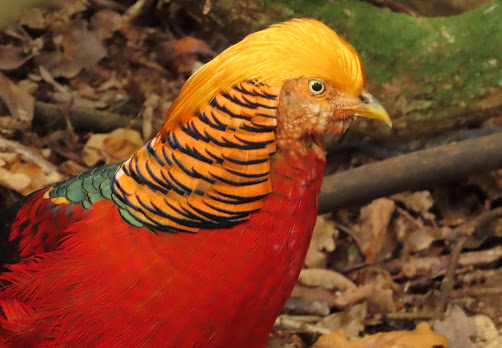St Mary's is the main island of the Scillies and the most populated and the most cultivated. The place is fairly civilised, a landscape of small fields with hedgerows, small copses, and rougher uncultivated areas. Like all the islands its a magnet for migrating birds, its variety of habitats providing shelter for weary travellers. At six square miles, its a small island, making it an easy place to walk around, any rare birds that turn up are easy to get to.
On the 8th, the first day on the Scillies, we met the group for the first time, And after that we had a quick look around the local area. With Hugh Town being so small, it was easy to get out of, to find bird rich countryside around it. On the low ground just beyond the town was Lower Moors, a large area of marshland, mainly overgrown with reeds, with some tree cover. On a pool, overlooked by a hide, a JACK SNIPE was present. What was strange about this sighting was that the bird was out in the open, not far from where it was being viewed, which for a jack snipe is very rare. This was the best sighting of this species I've ever had, usually I see them in flight, when they've been disturbed by me. The bird was asleep, before waking up and doing some feeding, its distinctive bobbing when it moved was characteristic of the bird. After that we walked to Carreg Dhu community gardens, where a bit of searching got us the first YELLOW BROWED WARBLER of the trip, high up in the trees constantly moving and providing its distinctive two note call.
The 10th of October was the first time to properly look round the island. East of the island in the Porth Hellick area there was a bag of goodies, bird wise. Rarest bird of the day was the BUFF BELLIED PIPIT at Porth Hellick Down, a not particularly exciting bird, but rare, even if brown. It was in a paddock, among a flock of very similar MEADOW PIPTS. The main difference between the two species was that the BBP had no stripes on its back while the mippits did. There was not much difference between the two species and to look at the BBP was not a remarkable bird at all. However it proved to be a magnet for twitchers looking for this rare bird. and this unremarkable pipit brought them in, with a decent crowd looking at it.
While twitching the BBP, news got out that a WRYNECK had been seen nearby. Wrynecks are a small brown woodpecker that used to nest in southern England, before coming extinct in late last century. Now they are scarce birds, every sighting attracting a small twitch. The bird was seen just downhill from the BBP, having shown on some rocks. When we got there it wasn't around, of course, but a brown bird flew out into a gorse clump. Most people, myself included, ignored it saying it wasn't the wryneck. However other people took an interest in the gorse clump, and would you have it, the bird showed, perching on a nearby rock for a while giving great views, before flying off down hill.
After the wryneck, walking downhill, to Porth Hellic Bay a female REDSTART was seen around a clump of bracken, which was my latest record for the species, and my first for October. Nearby was Porth Hellic Pool a large reed fringed lake overlooked by two hides. Not many wildfowl were present, but three GREENSHANK, and ten COMMON SNIPE were nice records. Nearby walking through the Holy Vale, an area of overgrown wet woodland, part of Higher Moors wetlands, a PIED FLYCATCHER was seen in a clearing and like the previous redstart my latest and first October record for the species.
Aside from the Porth Hellick area, things were fairly quiet. Being an island, even built up places can hold migrants. A COMMON ROSEFINCH was found in Hugh Town Allotments, along with a WHITETHROAT, and one of a small number of BLACKCAPS seen on the island. The rosefinch had been seen in a tree, but had become elusive but after a while the bird flew out to briefly expose itself in the open, looking a bit like a chaffinch I guess.
Being October there was a steady trickle of SWALLOWS migrating, a bird which has become rare in Suffolk, with a few HOUSE MARTINS, and even a few SAND MARTINS passing though, again my latest records for the latter species and my first for October. Aside from that a SANDWICH TERN was in Porth Loo Bay, this big tern is one of the first migrants to arrive and one of the last to leave, making the most of the English summer.
One small area, Porth Hellic proved to be a fertile area for sightings, which happens, when a lot of birders are concentrated in one place, meaning there's more coverage, more eyes searching the countryside, and as a result something else that's rare usually gets found. However aside from that the island was fairly quiet, and a lot of walking didn't produce much. It just seems that there are few birds around at the moment, probably a result of massive declines in their populations, with the sad truth that our countryside is just getting quieter and more empty.










































